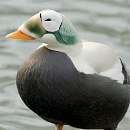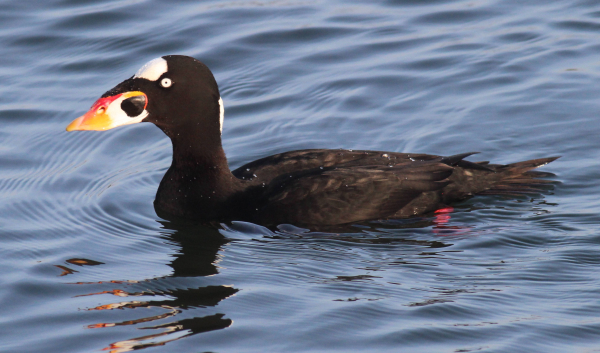
A bird rarely seen beyond the Arctic areas of the northern Pacific Coast and Bering Sea, a male Spectacled Eider is one of the many sea ducks found in North America (photo by Laura Whitehouse).

More likely to be seen at lower coastal latitudes, a male Surf Scoter is among the 3 species of scoters that can be found in the North American realm (photo by Paul Konrad).
|
Found among the icy waters along some ocean coasts, many birders aren’t very familiar with sea ducks, even though they represent a significant portion of the continent’s duck species. Among the 21 species of sea ducks found worldwide, an impressive 15 different species inhabit certain coastal areas of North America, such as Harlequin Ducks and Long-tailed Ducks, plus 4 species of eiders, 3 species of scoters, 3 species of mergansers, and 2 species of goldeneyes. Today, these unique marine ducks are receiving more attention from biologists, and birders.
With specialized salt glands, most sea ducks winter along the northern coasts of the Pacific and Atlantic Oceans, but nest further inland among the wetlands of the Arctic tundra and boreal taiga habitats. Their unique plumage designs and sometimes colorful and accentuated beak, along with their in diving behavior has captivated birders.
Over the past several decades, the visionary North American Waterfowl Management Plan and North American Wetlands Conservation Act have helped most waterfowl populations prosper; however, some sea ducks remain an exception. The 2022 State of the Birds report revealed a concerning 30 percent drop in sea duck numbers since 1970. Two species – Spectacled Eiders and Steller’s Eiders – have been federally listed as Threatened since 1997. Two other species – King Eiders and Black Scoters – were identified as “Tipping Point” species that have been reduced in numbers by at least 50 percent since 1970, and they are projected to lose another 50 percent in the next 50 years if no action is taken.
A significant response to declining sea duck populations is being conducted by the Sea Duck Joint Venture. Created from the North American Waterfowl Management Plan in the 1990s, this collaboration between the United States and Canada has been championing research and conservation efforts for sea ducks and their habitats across the continent. Through this alliance, the US Fish and Wildlife Service and Canadian Wildlife Service joined with Environment Canada, US Geological Survey, Bureau of Ocean and Energy Management, Ducks Unlimited, Birds Canada, all 4 Migratory Bird Flyway councils, and others.
Together, the Sea Duck Joint Venture combined more than 20 years of research information and created the world’s first Sea Duck Key Habitat Sites Atlas. This Atlas identifies 85 of the most important habitat areas for sea ducks in North America and provides valuable insights about conflicts that could potentially impact a species or their habitats in the future.
To compliment the Atlas, the Sea Duck Joint Venture has also created an open access interactive data visualization map. This has been instrumental in real-world applications, from being incorporated into the National Oceanic and Atmospheric Administration’s App to inform oil spill response and prevention, to providing information for Canada’s Marine Spatial Plans for exploratory oil and gas drilling. Together, these resources are not only important to raise awareness of sea duck habitats across their range, but also to help prioritize conservation work with more informed environmental assessments.
For more information about sea ducks and the work of the US Fish & Wildlife Service to ensure their future of these species in the wild, refer to Diving into the Mysterious World of Sea Ducks | U.S. Fish & Wildlife Service (fws.gov)